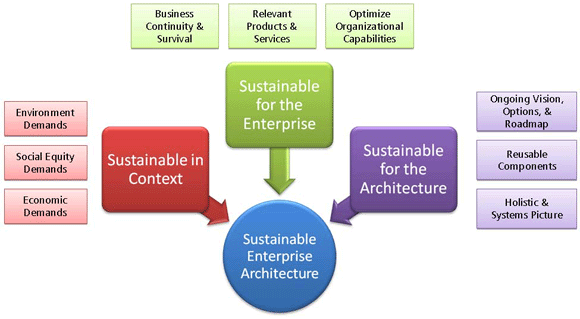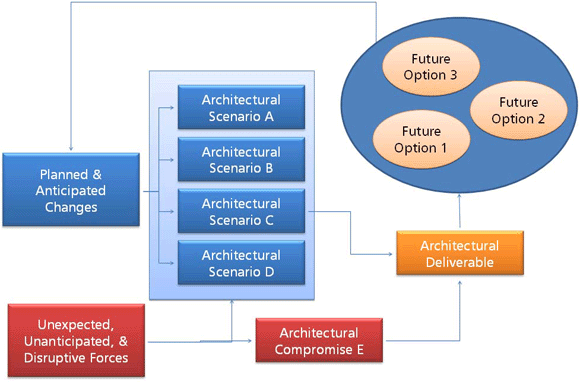Let's start with the premise that we are missing the potential input and direction that a focus on sustainable enterprise architecture could provide. For example, consider the following:
-
If we were to approach major projects with a holistic, EA overview in place, the resulting synergies would certainly reduce resources and time significantly, which in turn would have a big impact on green targets.
-
An holistic enterprise architecture would highlight situations where we could reduce our dependence on IT or reduce the volume or consumption of IT, while maintaining the same or improving capability.
In most situations of enterprise change and transformation, we can achieve better results by applying smart architectural thinking. This broadly involves using EA to maximize synergies and do more with less. A key role for the architect should be to advocate options and support decisions that promote long-term sustainability from an enterprise-wide perspective.
Let's move on with a useful summary of what we need to consider when making EA sustainable.
SUSTAINABLE EA
Cynics might argue that development can't coexist with sustainability. Maybe the best we can do is to minimize the damage that architecture development might cause. The 2005 World Summit on Social Development noted "three pillars" of sustainability, requiring reconciliation of environmental, social equity, and economic demands.1 Figure 1 includes these three pillars as a context for a sustainable EA, then adds two additional needs. To be fully sustainable, architecture must be:
-
Sustainable in context. Architectures must take into consideration and reconcile their demands on the environment, social equity, and the economy.
-
Sustainable for the enterprise. Architectures must support the continuation and ongoing survival of the enterprise and its business operations.
-
Sustainable for the architecture. Architectures must evolve in a way that is inherently constant, stable, and enduring.

Figure 1 -- Sustainable EA. (Adapted from United Nations.)
As with many other demands on the EA team, this is a big question to ask, but how can architects develop architecture that is sustainable in context, for the enterprise, and for the architecture?
Sustainable in Context
The first step in being sustainable in context is being fully aware of the environment in which the enterprise operates. I described this initial stage about how an organization needs to architect in an environmental context in a recent Executive Report.2 The next step is to make a sustainable response to these demands.
First let's clarify what I mean by sustainability in context (see Figure 2). Sustainable development has been defined in many ways, but a common and persistent theme originated in a report from 1987 that famously defined it as "development that meets the needs of the present without compromising the ability of future generations to meet their own needs."3 Architects will need to balance the desire of individuals and companies to realize and develop their potential against the protection of the Earth's natural ecosystems. For a commercial organization this can present a tough challenge to the normal focus on profitability.

Figure 2 -- A context for sustainable development.
The typical enterprise architect is not likely to directly decide organization strategy, but he or she can make a difference by suggesting new ideas to the decision-making process. The most powerful EA technique is to define relevant principles. Here are some examples:
-
Respect environmental limits -- to develop architectures that have a high regard for the fair use of natural resources. A simple example is using clean technologies to replace energy- and material-intensive ones.
-
Strong and just society -- to ensure that architectures meet the diverse needs of communities that they impact; for example, in architecting processes to address ethnic and linguistic diversity.
-
Sustainable economy -- to use architecture to encourage a strong and stable economy that is fair or provides opportunities for others. One client organization includes the environmental and social costs when assessing architectural alternatives.
-
Participative governance -- to engage a wide range of people to contribute their ideas, energy, and diversity in decision making. Another client initiated a voluntary cross-discipline green team to generate ideas for greater sustainability.
It is ironic that EA could make a huge contribution to developing a sustainable environment, but that many architects are not even participating in enterprise-level decision making. There are exceptions, and these can be inspirational. The Global 100 is an annual project, launched in 2005, to evaluate the world leaders in "clean capitalism."4 Each year it short-lists companies based on their sustainability disclosure practices, financial health, product category, and financial sanctions. It then analyzes companies against 12 KPIs: energy, carbon, water and waste productivity, innovation capacity, percentage tax paid, CEO to average employee pay, pension fund status, safety performance, employee turnover, leadership diversity, and clean capitalism pay link.
Based on the screening and selection criteria, EA teams could:
-
Include the key indicators that are most frequently disclosed by peers in their respective industry to assess sustainability. Some KPIs are more suited to assessing the EA role. For example, it is relatively easy to assess energy, carbon, water, and waste, and relate these to alternative enterprise patterns as a basis for choosing sustainable options.
-
Examine money that the enterprise has paid out in fines, penalties, or settlements on a trailing one-year basis. These payouts are an excellent indicator of where the organization has failed in environmental areas such as customer exploitation, environmental pollution, or infringement of regulations.
-
Establish a forum to encourage ideas and innovations that are sustainable. Through one such forum a bank set up an online money manager to help customers manage and categorize their finances; the categories that customers used were not the same as the bank had used in the past to analyze customer spending habits, and using the new set of categories led to rearchitecting customer-facing processes and products.
EA teams can also get to know the work of organizations that provide advice and research into sustainable development, such as the Canadian-based International Institute for Sustainable Development (IISD) or the Forum for the Future.5 To paraphrase IISD, "any form of [EA] development that is not sustainable contains the seeds of its own destruction." IISD states that it has chosen "to focus on topics that are ripe for transformation -- where a shift in policy has the potential to snowball and, before too long, to change the nature of the game."6 Too often the focus on EA is business as usual, whereas it truly comes into its own when attention is on transformation.7 And the Forum for the Future wants "to transform the complex systems which serve our fundamental needs -- such as food, energy, and finance -- so that they are fit for the 21st century,"8 through projects that focus on topics such as a creating a framework for a sustainable economy.
In addition, there is much to be learned by following the example of thought leaders in this area. For instance, Coca-Cola developed a value chain strategy that specifically linked production and consumption issues. Standard Chartered explored how sustainability was critical for ensuring the success of the century-and-a-half-old bank "for the next 150 years." And HP has established an ongoing dialogue at the corporate level with sustainability thought leaders.
Sustainable for the Enterprise
I've made a big point of the context for EA, because I feel that this is the arena in which we can make the biggest impact. In a world that is becoming more and more connected, developing sustainable EA will be an imperative. Another strong argument in favor of sustainable development is that it makes financial sense for companies to proactively manage their social, environmental, and wider economic impacts.
EA nearly always faces demands to cut costs, and a sustainable way to do so is to reduce the resource intensity of enterprise architecture through eco-efficiency. Other benefits include first-mover advantage in stimulating new market opportunities and attracting investment, motivated employees, and satisfied customers as a consequence of the improved corporate reputation that comes from dealing responsibly with social and environmental issues.
Ultimately, as Figure 1 illustrates, sustainable EA for the enterprise is about ensuring business continuity and the survival of the organization; delivering products and services that are relevant to customers; and creating, improving, and making effective use of core organizational capabilities. For the enterprise architect, it is better to focus on these outcomes than to talk directly about sustainability. From experience, I have found that basing the discussion around sustainability is a quick route to being shown the boardroom door. Sustainability is still seen today as a niche strategy. Its financial benefits are often not viewed as substantial or real enough to justify buy-in and investment. The return on sustainability may not be as obvious as returns generated through other investments. Short-term profit maximization is the key motivation, and this is particularly true when environmental and social costs can be externalized. In other words, the real costs of nonsustainable policies are borne by people, communities, and environments that don't appear on the corporate scoreboard.
The enterprise must include architectural thinking as part of an iterative business development cycle if it wants to support a fully sustainable business model. Figure 3 shows an iterative cycle that could easily be mapped to any architecture development method (such as TOGAF's ADM).9 It shows that architecture needs to be involved in strategy and planning but, more crucially, it shows that deployed solutions are based on architectural thinking and that feedback and monitoring of solutions is filtered and interpreted by architectural thinking before it becomes input to strategy and planning.

Figure 3 -- Architecture in a sustainable business cycle. (Adapted from Laverdure and Conn.)
The EA team should certainly introduce measures to show the broader context, but from an enterprise perspective, it needs to focus on the more obvious and practical benefits that EA delivers, including the following:
-
The current move toward capability-based strategies and planning helps to ensure the sustainability of the enterprise.
-
Extending the scope of EA so that it covers business products and processes can help. In fact, EA techniques can be applied to any business or management topic that is conceptual in nature -- so strategies, brands, organizational structures, skills, capabilities, events and triggers, processes, products, value propositions, and many other areas are all fair game.
-
One final, and vital, suggestion is to raise the profile of the EA team by engaging in the strategy planning and transformation processes. This can be difficult for a team that is grounded too much in the IT department. In that case it is a question of developing artifacts that make sense at a business and strategy level, and that have an enterprise-wide rather than a segment scope. Enterprise patterns are an emerging technique that works very well.
As shown here, how well you can influence or direct sustainability in context and for the enterprise depends very much on the role and position of the EA team within the enterprise. But in the final arena, we are firmly within the responsibilities of the architect.
Sustainable for the Architecture
Architects have a lot more say and control in making the architecture itself sustainable. By developing an ongoing vision, future options, and a set of architecture roadmaps; by creating components that can be reused in many different contexts; and by having an holistic and systems perspective on the enterprise, the EA team helps to establish an enterprise architecture that is enduring and capable of evolving to meet changing needs.
Here, sustainable EA is possible. Organizations that achieve sustainable EA have three critical things are in common (see Figure 4):

Figure 4 -- Sustainable architectures.
-
When they plan architectural change, they anticipate requirements that are likely to affect the future direction of EA. They then create alternative scenarios that will address these needs, and allow decision makers to weigh the pros and cons of each option. Each scenarios in Figure 4 represents an anticipated and planned change that ensures continuity and sustainability of the architecture.
-
Even more important for sustainability is that each scenario contains the seeds or the possibility for future architectural evolution. In other words, each scenario that becomes embedded in an enterprise enables or allows clearly defined future options. In Figure 4, if the organization pursues scenario C, this will allow it to consider future options 1 to 3, because these are all enabled by delivering on scenario C.
-
Finally, the EA team needs to recognize that there are unexpected, unanticipated, and disruptive forces that will force it to modify its plans, resulting in architectural compromise. This is where sustainability can be thrown off track, so it is vital to realign any compromise with planned options to minimize divergence from a sustainable architectural vision.
CONCLUSION
We began this Update by asking whether EA can be sustainable. The answer is that it can be, but to be fully sustainable EA needs to be sustainable in context, for the enterprise, and for the architecture. This is a big balancing act, but it is in such complex and challenging arenas that EA excels. Perhaps a more important question is whether EA should try to be sustainable. The answer is illustrated in Figure 1. In context, EA should be sustainable on ethical and moral grounds. Of course we should be developing architecture that is beneficial for all. For the enterprise, sustainable EA is the most effective way to ensure organizational survival and business continuity. And for the architecture, sustainable EA delivers the best ROI and the most efficient use of resources. I will examine the value and benefits of EA in a future Executive Report.
I welcome your feedback, comments, and questions on this topic. Feel free to email me at revernden@cutter.com.
ENDNOTES
1 "2005 World Summit Outcome, Resolution A/60/1." United Nations, General Assembly, 24 October 2005 (http://data.unaids.org/Topics/UniversalAccess/worldsummitoutcome_resolution_24oct2005_en.pdf).
2 Evernden, Roger. "The Environmental Context for EA: The Imperative to Deal with Uncertainty." Cutter Consortium Business & Enterprise Executive Report, Vol. 15, No. 7, 2012.
3 "Our Common Future." Report of the World Commission on Environment and Development. United Nations, 1987 (http://conspect.nl/pdf/Our_Common_Future-Brundtland_Report_1987.pdf).
4The Global 100 (www.global100.org).
5International Institute for Sustainable Development (www.iisd.org) and Forum for the Future (www.forumforthefuture.org).
6International Institute for Sustainable Development (www.iisd.org/about).
7 Evernden, Roger. "Enterprise Patterns: The Key to Effective EA Application as Transformation." Cutter Business & Enterprise Architecture Executive Report, Vol. 14, No. 8, 2011.
8Forum for the Future (www.forumforthefuture.org/about).
9 Laverdure, Leo, and Alex Conn. "SEA Change: How Sustainable EA Enables Business Success in Times of Disruptive Change." Journal of Enterprise Architecture, Vol. 8, No. 1, February 2012.



